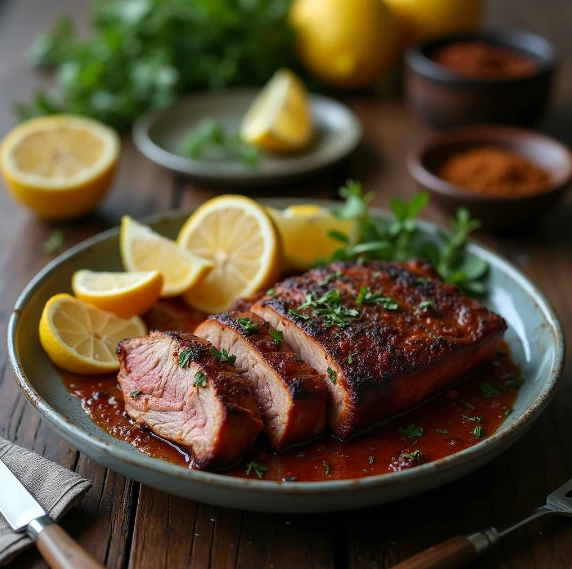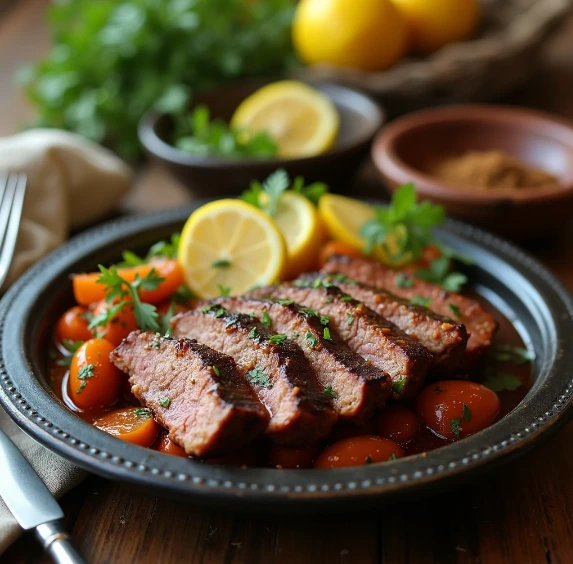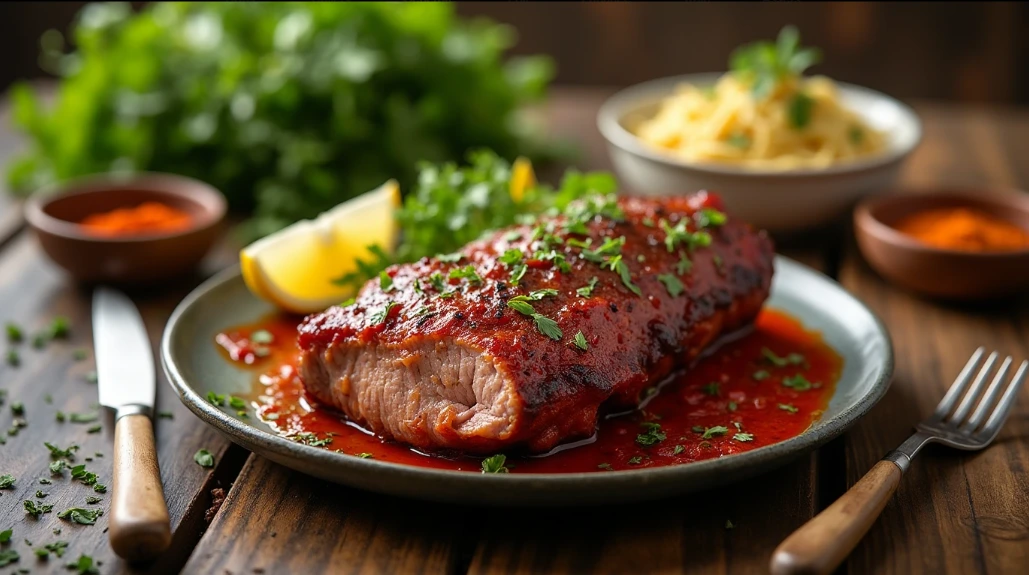Smoking food is an art form that brings unparalleled depth and complexity to your favorite dishes. Whether you’re a backyard beginner or a seasoned pitmaster, smoker recipes elevate ordinary ingredients to extraordinary flavors. Below, we dive into a comprehensive guide packed with delicious recipes, tips, and techniques to take your smoking skills to the next level.

| Heading | Subheading |
|---|---|
| Introduction | Benefits of Using a Smoker |
| Smoker Recipes | What Makes Smoking Unique? |
| Choosing the Right Smoker | Types of Smokers and Their Features |
| Essential Tools for Smoking | Must-Have Equipment for Success |
| Preparing Your Ingredients | How to Marinate and Season for Smoking |
| Beginner-Friendly Smoker Recipes | Smoked Chicken Wings, Pulled Pork |
| Advanced Smoker Recipes | Beef Brisket, Smoked Turkey |
| Smoker-Friendly Vegetables | Grilled Corn, Smoked Bell Peppers |
| Smoking Seafood | Cedar-Planked Salmon, Smoked Shrimp |
| Smoking for Vegetarians | Smoked Tofu and Plant-Based Dishes |
| Tips for Perfect Smoking | Managing Temperature and Smoke Levels |
| Wood Selection for Smokers | Best Woods for Different Meats and Flavors |
| Creating Your Signature Rub | Easy DIY Spice Blends for Smokers |
| Enhancing with Marinades | Top Marinade Recipes for Smoking Success |
| The Science of Smoking | How Smoking Infuses Flavor into Food |
| Common Mistakes to Avoid | Troubleshooting Smoker Issues |
| Cleaning and Maintaining a Smoker | Tips for Longevity and Better Performance |
| Healthier Smoker Recipes | Smoking Without the Guilt |
| Smoking in Cold Weather | Techniques for All-Season Smoking |
| Side Dishes to Pair with Smoked Foods | Perfect Complements for Smoked Dishes |
| Smoking Desserts | Smoked Cheesecake, Apple Pie |
| Regional Smoking Styles | Texas, Memphis, Carolina BBQ Traditions |
| Using Leftovers | Creative Ideas for Leftover Smoked Meats |
| Smoking Safety Tips | Precautions and Safe Practices |
| FAQs About Smoking | Addressing Common Questions |
Benefits of Using a Smoker
Smoking enhances the flavor of your food, offering a depth that no other cooking method can replicate. The slow-cooking process tenderizes tough cuts of meat while infusing a rich smoky aroma. Whether you’re crafting a savory brisket or experimenting with smoked vegetables, smoking adds an element of gourmet flair to your meals.
What Makes Smoking Unique?
Smoking combines low temperatures and wood-infused flavors to transform simple ingredients into culinary masterpieces. Unlike grilling, which relies on direct heat, smoking cooks food indirectly, allowing flavors to penetrate deeply. This method produces juicy, tender results that are perfect for meat, fish, and even desserts.
Types of Smokers and Their Features
Charcoal Smokers
Charcoal smokers deliver a traditional smoky flavor, offering control over temperature and smoke levels. They require manual monitoring but reward you with authentic results.
Electric Smokers
Electric smokers are user-friendly and maintain consistent temperatures, making them ideal for beginners. They offer convenience without sacrificing flavor.
Pellet Smokers
Pellet smokers use wood pellets as fuel, providing a steady source of heat and smoke. They’re versatile, allowing you to smoke, grill, and bake with precision.
Offset Smokers
Offset smokers are favored by pitmasters for their ability to handle large quantities of food. They provide exceptional results but require more hands-on effort.
Beginner-Friendly Smoker Recipes
Smoked Chicken Wings
- Ingredients: Chicken wings, salt, pepper, garlic powder, and paprika.
- Instructions:
- Season wings generously.
- Smoke at 225°F for 1.5–2 hours.
- Finish with a quick sear for crispy skin.
Pulled Pork
- Ingredients: Pork shoulder, brown sugar, chili powder, apple cider vinegar.
- Instructions:
- Rub pork with spices and refrigerate overnight.
- Smoke at 225°F for 8–10 hours until tender.
- Shred and serve with BBQ sauce.
Smoker-Friendly Vegetables
Grilled Corn on the Cob
- Ingredients: Fresh corn, butter, salt, and pepper.
- Instructions:
- Brush corn with butter and season.
- Smoke at 250°F for 45 minutes.
- Rotate occasionally for even cooking.
Smoked Bell Peppers
- Ingredients: Bell peppers, olive oil, herbs, and garlic.
- Instructions:
- Slice peppers and coat with olive oil and herbs.
- Smoke at 225°F for 1 hour.
Wood Selection for Smokers
Choosing the right wood is crucial for achieving the desired flavor.
- Hickory: Bold and smoky, perfect for pork and ribs.
- Mesquite: Strong and earthy, ideal for beef.
- Applewood: Sweet and fruity, great for poultry and fish.
- Cherrywood: Mild and sweet, pairs well with vegetables and desserts.
Creating Your Signature Rub
A personalized rub can elevate any smoked dish. Combine brown sugar, salt, smoked paprika, garlic powder, onion powder, and cayenne for a versatile blend that works on meat and vegetables alike.
FAQs About Smoking
How long should I smoke different types of meat?
- Cooking times vary by type and size. Chicken typically takes 2–3 hours, while brisket requires up to 12 hours.
What’s the best smoker for beginners?
- Electric smokers are ideal for beginners due to their ease of use and consistent results.
Can you smoke desserts?
- Absolutely! Cheesecake and fruit pies develop a unique flavor when smoked.
What’s the best temperature for smoking?
- Most recipes require temperatures between 225°F and 250°F for optimal results.
How often should I add wood to the smoker?
- Add wood every 45 minutes to an hour to maintain consistent smoke levels.
What’s the best way to clean a smoker?
- Remove ash and grease regularly. Use a grill brush and warm, soapy water for deep cleaning.
Conclusion
Smoker recipes transform ordinary meals into extraordinary feasts, combining the richness of smoky flavors with perfectly cooked ingredients. From tender brisket to vibrant smoked vegetables, there’s a recipe for every palate. Experiment with different woods, spices, and techniques to create your signature dishes. With the tips and recipes in this guide, you’re well on your way to mastering the art of smoking.
Seafood, with its delicate texture and subtle flavors, becomes a showstopper when smoked correctly. Here are two standout recipes for seafood lovers.
Cedar-Planked Salmon
- Ingredients: Salmon fillets, olive oil, fresh dill, lemon slices, cedar planks.
- Instructions:
- Soak the cedar planks in water for at least 2 hours.
- Brush salmon with olive oil, then season with salt, pepper, and dill.
- Lay lemon slices on top of the salmon.
- Place the fillets on the soaked cedar planks and smoke at 225°F for 45–60 minutes, or until the salmon flakes easily with a fork.
Smoked Shrimp Skewers
- Ingredients: Large shrimp, garlic butter, lemon juice, and fresh parsley.
- Instructions:
- Toss shrimp in melted garlic butter and lemon juice.
- Thread shrimp onto skewers, ensuring even spacing.
- Smoke at 225°F for 25–30 minutes, brushing with extra butter halfway through.
- Garnish with parsley and serve hot.
Smoking for Vegetarians
Smoking isn’t just for meat lovers. Vegetarians can enjoy the smoky, robust flavors with creative plant-based recipes.
Smoked Tofu
- Ingredients: Firm tofu, soy sauce, smoked paprika, maple syrup.
- Instructions:
- Press tofu to remove excess water, then cut into slices.
- Marinate in a mixture of soy sauce, smoked paprika, and maple syrup for at least 1 hour.
- Smoke at 200°F for 2 hours, flipping halfway through.
Stuffed Portobello Mushrooms
- Ingredients: Large portobello mushrooms, cream cheese, spinach, and breadcrumbs.
- Instructions:
- Remove stems and brush mushrooms with olive oil.
- Fill with a mixture of cream cheese, chopped spinach, and breadcrumbs.
- Smoke at 225°F for 1 hour until mushrooms are tender and filling is golden.
Tips for Perfect Smoking
Temperature Control
Maintaining a consistent temperature is key to successful smoking. Always use a reliable thermometer to monitor both the smoker’s internal temperature and the food’s progress.
Moisture Management
To prevent drying out, use a water pan inside the smoker to maintain humidity. Basting meat or wrapping it in foil partway through the cook can also help lock in juices.
Timing and Patience
Smoking is a low-and-slow process. Rushing the cook time will compromise the texture and flavor. Trust the process and savor the results!
Side Dishes to Pair with Smoked Foods
A smoked feast isn’t complete without the right accompaniments. Here are some mouthwatering ideas for side dishes that complement smoky flavors perfectly.
Smoked Mac and Cheese
- Ingredients: Elbow macaroni, cheddar cheese, milk, and breadcrumbs.
- Instructions:
- Prepare mac and cheese as usual, then transfer to a smoker-safe dish.
- Sprinkle breadcrumbs on top and smoke at 225°F for 1 hour until bubbly and golden.
Smoked Baked Beans
- Ingredients: Canned beans, bacon, onion, brown sugar, and BBQ sauce.
- Instructions:
- Combine ingredients in a cast-iron skillet.
- Smoke at 250°F for 2 hours, stirring occasionally.

Cornbread with Smoked Butter
- Ingredients: Cornbread mix, milk, eggs, and smoked butter.
- Instructions:
- Prepare cornbread according to package directions.
- Smoke butter separately for 1 hour and serve alongside warm cornbread.
Smoking Desserts
For a unique twist, try smoking your favorite desserts to add complexity and warmth to traditional recipes.
Smoked Cheesecake
- Ingredients: Graham cracker crust, cream cheese, sugar, and eggs.
- Instructions:
- Prepare the cheesecake batter and pour it into a springform pan.
- Place in the smoker at 225°F for 2 hours until set.
- Chill before serving with a drizzle of caramel sauce.
Smoked Apples with Cinnamon
- Ingredients: Whole apples, brown sugar, cinnamon, and butter.
- Instructions:
- Core apples and fill with a mixture of brown sugar and cinnamon.
- Smoke at 225°F for 1.5 hours, basting occasionally with melted butter.
The Science of Smoking
Smoking works by combining heat, smoke, and time to create complex flavors. As wood burns, it releases chemical compounds that interact with the food’s surface, forming the signature “smoke ring” in meats and enhancing taste. Understanding the science can help refine your technique and produce consistently delicious results.
The journey of mastering smoker recipes is as fulfilling as the meals themselves. With the right tools, ingredients, and a bit of patience, you can create unforgettable dishes that leave a lasting impression. Smoked food isn’t just a meal—it’s an experience that brings people together, blending tradition, creativity, and flavor in every bite.
Regional Smoking Styles
Smoking techniques vary significantly across regions, each boasting distinct flavors and methods that reflect cultural and culinary traditions. Here are a few noteworthy styles:
Texas BBQ
Known for its bold and robust flavors, Texas-style smoking focuses on beef, particularly brisket. The meat is seasoned simply with salt and pepper, allowing the smoky flavor to shine. Post oak is the wood of choice, imparting a rich and earthy aroma.
Memphis BBQ
Memphis specializes in smoked pork, particularly ribs. The style uses a dry rub made from a mix of paprika, garlic powder, and brown sugar. Sauce is served on the side, letting the meat’s natural flavor take center stage.
Carolina BBQ
Carolina smoking emphasizes pork shoulder and whole hog cooking, with a tangy vinegar-based sauce. Hickory and applewood are popular choices, adding a mild sweetness to complement the meat.
Kansas City BBQ
Kansas City barbecue is famous for its sweet and sticky sauces, often slathered generously over ribs and burnt ends. A variety of woods, including hickory and cherry, contribute to the signature flavor.
Smoking in Cold Weather
Smoking during the winter months presents unique challenges but can be equally rewarding with proper preparation.
Maintain Heat
Cold weather affects smoker temperature, so insulation is crucial. Use a smoker jacket or a DIY thermal blanket to minimize heat loss.
Stock Up on Fuel
Smoking in the cold requires more fuel to maintain steady temperatures. Ensure you have plenty of charcoal, wood, or pellets before starting.
Preheat Your Smoker
Allow extra time to preheat your smoker in cold conditions. This step ensures consistent cooking temperatures from start to finish.
Healthier Smoker Recipes
Smoking doesn’t have to be indulgent. With the right ingredients and techniques, you can create nutritious and delicious dishes.
Smoked Chicken Breast
Opt for lean chicken breasts over thighs or wings. Brine the chicken to keep it juicy, then smoke with mild woods like apple or cherry.
Smoked Vegetables
Smoking vegetables like zucchini, carrots, and broccoli is a fantastic way to retain nutrients while adding smoky depth. A light olive oil coating and seasoning elevate their natural flavors.
Smoked Fish
Fish like salmon and mackerel are rich in omega-3 fatty acids. Smoking them with cedar planks or alder wood enhances their nutritional value without compromising flavor.
Using Leftovers
Leftover smoked meats can transform into incredible new dishes. Here are some creative ideas:
Smoked Meat Tacos
Shred leftover brisket or pulled pork and use it as a filling for tacos. Add fresh salsa, avocado, and lime for a refreshing twist.
Smoked Meat Chili
Dice leftover smoked meats and add them to a pot of chili for a smoky, hearty meal. The depth of flavor intensifies with slow cooking.
Smoked Pizza
Use smoked chicken or brisket as a topping for homemade pizza. Pair with barbecue sauce and smoked mozzarella for a gourmet experience.
Common Mistakes to Avoid
Even experienced pitmasters occasionally make mistakes. Avoid these common pitfalls to ensure smoking success:
- Using Too Much Wood: Over-smoking can make food bitter. Use small, consistent amounts of wood.
- Opening the Smoker Too Often: Every time you open the smoker, heat and smoke escape. Limit this to maintain consistent cooking.
- Skipping the Resting Period: Always let smoked meats rest before slicing to redistribute juices and enhance tenderness.
Smoker Recipes for Large Gatherings
Smoking food is perfect for feeding a crowd, as the slow-cooking process allows you to prepare large quantities of food with unmatched flavor. Here are a few recipes ideal for parties and gatherings.
Whole Smoked Turkey
- Ingredients: Turkey, butter, garlic, fresh thyme, and rosemary.
- Instructions:
- Brine the turkey for 24 hours in a mixture of water, salt, and sugar.
- Rub the turkey with softened butter and season with garlic, thyme, and rosemary.
- Smoke at 225°F for 30–40 minutes per pound, basting occasionally.
- Let rest for 20 minutes before carving.
Smoked Ribs for a Crowd
- Ingredients: Pork ribs, dry rub, apple juice, BBQ sauce.
- Instructions:
- Remove the membrane from the ribs and coat them with a dry rub.
- Smoke at 225°F for 3 hours.
- Wrap in foil with apple juice and return to the smoker for 2 hours.
- Unwrap, brush with BBQ sauce, and smoke for 1 more hour.
Creative Wood Combinations for Smoking
Combining different types of wood can produce unique and complex flavors. Experiment with these combinations to add a personal touch to your dishes:
- Hickory and Cherry: Perfect for pork and poultry, balancing boldness with sweetness.
- Oak and Mesquite: Ideal for beef, adding a strong, smoky flavor with a hint of earthiness.
- Apple and Pecan: A great choice for desserts, adding a fruity and nutty aroma.
- Maple and Alder: Excellent for seafood, offering mild, sweet undertones.
Smoking Techniques for Beginners
Starting with the basics helps beginners master the art of smoking. Here are a few foolproof techniques:
The 3-2-1 Method for Ribs
This method involves smoking ribs for 3 hours unwrapped, 2 hours wrapped in foil, and 1 hour unwrapped with sauce. It’s a fail-safe way to achieve tender, fall-off-the-bone ribs.
Using a Water Pan
Adding a water pan inside your smoker helps maintain moisture and stabilize temperature. This is particularly helpful for long smoking sessions.
Reverse Searing
For steaks and thicker cuts, smoke the meat at a low temperature until almost done, then sear it over high heat for a caramelized crust.
Incorporating Smoking into Everyday Cooking
Smoking isn’t just for special occasions; it can be part of your daily culinary routine.
Smoked Breakfast Dishes
Start your day with smoked breakfast items like smoked bacon, eggs, or hash browns. These dishes bring a gourmet twist to your mornings.
Smoked Sandwiches
Use smoked meats or vegetables as fillings for sandwiches. Smoked chicken paired with fresh greens and a tangy dressing makes a quick, delicious lunch.
Smoked Sauces and Spices
Enhance your meals with smoked spices or sauces. Smoking whole peppers or garlic cloves allows you to create your own smoked seasonings and condiments.
FAQs About Smoker Recipes
How do I clean a smoker after cooking?
- Clean your smoker by removing ash and grease buildup. Use a brush to scrub the grates and a damp cloth for the exterior.
Can I use any wood for smoking?
- Only use hardwoods like oak, hickory, apple, and cherry. Avoid softwoods like pine, as they contain resins that can ruin the flavor and release harmful toxins.
How do I know when smoked meat is done?
- Use a meat thermometer to check the internal temperature. For example, brisket should reach 195–205°F, while chicken should be at 165°F.
Why is my smoked meat bitter?
- Bitter flavors often result from over-smoking or using too much wood. Ensure the wood is properly seasoned and avoid excessive smoke.
What’s the difference between hot and cold smoking?
- Hot smoking cooks the food at temperatures between 200°F and 275°F, while cold smoking preserves food by exposing it to smoke at 70°F to 90°F without cooking it.
Conclusion
Smoking recipes open up a world of culinary possibilities, blending tradition, creativity, and incredible flavors. With patience, practice, and the right techniques, anyone can master the art of smoking and create unforgettable meals. From beginner-friendly dishes to advanced techniques, this guide serves as your comprehensive resource for all things smoking.
Whether you’re preparing a casual dinner or hosting a grand barbecue, smoker recipes are sure to impress. So, fire up your smoker, experiment with new woods and flavors, and savor the results of your hard work.
Follow us for recipes on Facebook

